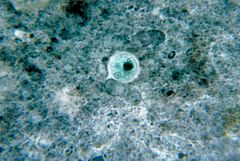Conosa facts for kids
Quick facts for kids Conosa |
|
|---|---|
 |
|
| Entamoeba histolytica cyst | |
| Scientific classification | |
| Domain: | |
| Kingdom: | |
| Phylum: | |
| Subphylum: |
Conosa
Cavalier-Smith, 1998
|
| Infraphyla | |
The Conosa are a major group of tiny living things called Amoebozoa. Think of them as a big branch on the Amoebozoa family tree! These organisms are so small you need a microscope to see them.
What are Conosa?
The Conosa group is one of three main subphyla within the Amoebozoa. A subphylum is like a large division within a bigger group of living things. Scientists have divided Conosa into two smaller groups, called infraphyla:
- Mycetozoa: These are a type of slime mould. Slime moulds are fascinating organisms that can sometimes act like a single-celled amoeba and other times come together to form a larger, visible structure.
- Archamoebae: A special feature of Archamoebae is that they do not have mitochondria. Mitochondria are like the powerhouses of most cells, creating energy. Archamoebae get their energy in different ways.
Examples of Conosa
The Conosa group includes many interesting species. Two well-known examples are Dictyostelium discoideum and Entamoeba histolytica.
- Dictyostelium discoideum is a type of social amoeba. It's often studied to understand how single cells can work together to form a larger, more complex organism.
- Entamoeba histolytica is a type of amoeba that can sometimes cause health problems in humans.
Discovering New Species
Scientists know about 2,000 different species of Conosa. However, they believe there are many more waiting to be discovered! It can be tricky to tell them apart because they often look very similar under a microscope. They don't have many clear features that help scientists classify them easily.
But thanks to new tools like molecular biology, scientists can now study their DNA. By looking at their DNA, they can find differences that aren't visible. This helps them identify new species and understand how they are related.
Images for kids
-
Entamoeba histolytica trophozoite
See also
 In Spanish: Conosa para niños
In Spanish: Conosa para niños




